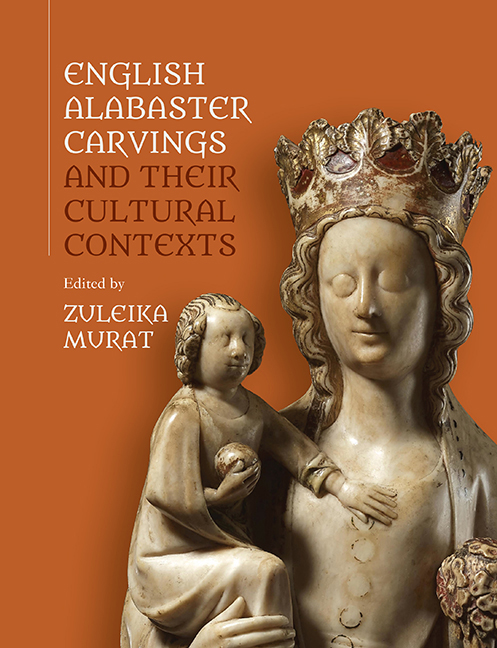Book contents
- Frontmatter
- CONTENTS
- List of Illustrations
- Acknowledgements
- List of Contributors
- Introduction
- 1 ‘Burton-Upon-Trent, Not Nottingham.’ the Evolving Study Of Medieval English Alabaster Sculpture
- 2 Stone to Ensure Victory and to Generate Friendships. On The Meaning of Alabaster
- 3 Contextualising English Alabasters in the Material Culture of the Medieval Mediterranean
- 4 English Alabaster Images As Recipients of Music in the Long Fifteenth Century: English Sacred Traditions in a European Perspective
- 5 Contextualising Alabasters in Their Immersive Environment. The ‘Ancona D'Allabastro Di Diverse Figure’ of the Novalesa Abbey: Meaning and Function
- 6 Alabaster Carvings in Late-Medieval Lincolnshire
- 7 ‘Tabernacles, Howsynges and Other Things’. Three Alabasters From the Burrell Collection in Context
- 8 Conservation Study of Three Alabaster Carvings From the Burrell Collection, Glasgow Museums
- 9 ‘Smooth as Monumental Alabaster’. the Alabaster Tomb Industry in England 1550–1660
- 10 Merchants’ Tombs in Alabaster
- 11 Exploring Alice: the Theological, Socio-Historical, and Anatomical Context of the De La Pole Cadaver Sculpture
- Bibliography
- Index
- Already Published
10 - Merchants’ Tombs in Alabaster
Published online by Cambridge University Press: 14 September 2019
- Frontmatter
- CONTENTS
- List of Illustrations
- Acknowledgements
- List of Contributors
- Introduction
- 1 ‘Burton-Upon-Trent, Not Nottingham.’ the Evolving Study Of Medieval English Alabaster Sculpture
- 2 Stone to Ensure Victory and to Generate Friendships. On The Meaning of Alabaster
- 3 Contextualising English Alabasters in the Material Culture of the Medieval Mediterranean
- 4 English Alabaster Images As Recipients of Music in the Long Fifteenth Century: English Sacred Traditions in a European Perspective
- 5 Contextualising Alabasters in Their Immersive Environment. The ‘Ancona D'Allabastro Di Diverse Figure’ of the Novalesa Abbey: Meaning and Function
- 6 Alabaster Carvings in Late-Medieval Lincolnshire
- 7 ‘Tabernacles, Howsynges and Other Things’. Three Alabasters From the Burrell Collection in Context
- 8 Conservation Study of Three Alabaster Carvings From the Burrell Collection, Glasgow Museums
- 9 ‘Smooth as Monumental Alabaster’. the Alabaster Tomb Industry in England 1550–1660
- 10 Merchants’ Tombs in Alabaster
- 11 Exploring Alice: the Theological, Socio-Historical, and Anatomical Context of the De La Pole Cadaver Sculpture
- Bibliography
- Index
- Already Published
Summary
From the 1330s, alabaster was a material of status used to commemorate the elite of England. It was used initially for royal tombs (Edward II, John of Eltham, William of Hatfield, the dowager Queen Isabella and Philippa of Hainaut), bishops (John Stratford, William Eddington, Ralph of Shrewsbury, Thomas Hatfield and others) and the nobility. During the second half of the fourteenth century it became the conventional material for knights’ tombs and was occasionally also used for members of the legal profession. By and large, the merchant classes seem to have been excluded from this elite form of commemoration. Very few had effigial tombs, whether of alabaster or other any material, though some, like the merchants of Northleach, had floor brasses. A tiny group of alabaster merchants’ tombs also survives, virtually unstudied to date, so the aim here is to redress this omission. Why only those few select merchants were commemorated in alabaster is a question difficult to answer, as we shall see.
In the late medieval period social status and wealth did not necessarily go together. The average English merchant was significantly wealthier than the average knight and sometimes the nobility, but a stigma was attached to that wealth. According to the chivalric code, it was acceptable to make money through warfare, advantageous marriage or activities at court but not through commerce. Merchants and their families were in theory tainted by virtue of their activity. How much this actually mattered in practice to dowry-seeking social superiors is debatable, and not all merchants necessarily hungered after gentle status. They did behave increasingly like their social superiors, however, building stone houses, endowing religious institutions and, if sumptuary laws can be taken to arise out of actual behaviours that needed to be curbed, dressing grandly. The sumptuary laws of 1363 required merchants to have goods worth L500 in order to claim the privileges of squires and gentlemen worth only L100. The desire for distinctive commemoration after death would seem on the face of it to be consistent with the alleged social ambitions of the merchant class. Yet only a small number of merchants were commemorated in alabaster like the landed classes.
- Type
- Chapter
- Information
- English Alabaster Carvings and their Cultural Contexts , pp. 236 - 275Publisher: Boydell & BrewerPrint publication year: 2019



